The Pomegranate, scientifically known as Punica granatum, is a delightful fruit-bearing deciduous shrub in the family Lythraceae. Its rich history and captivating taste have made it a favorite among farmers and consumers alike. Pomegranate farming is the practice of cultivating Pomegranate trees to harvest their fruits. It plays a crucial role in agriculture due to the fruit’s high demand and numerous health benefits.
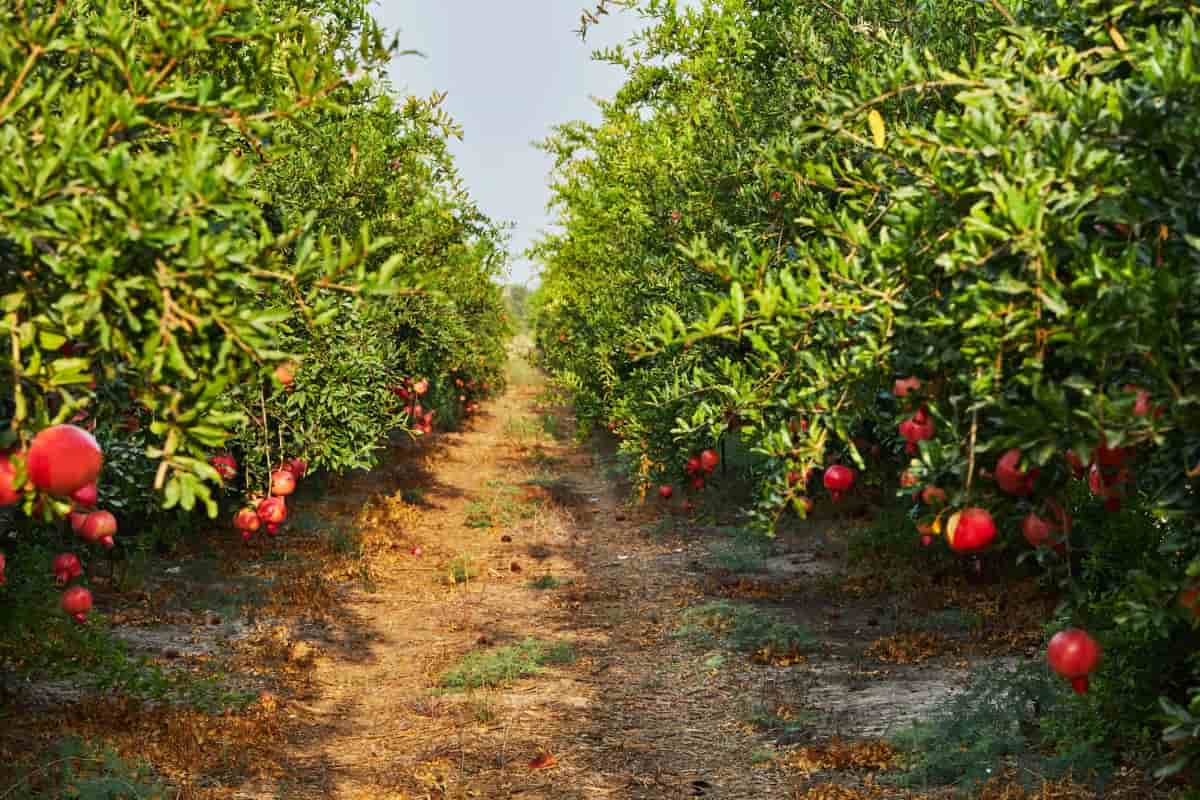
Best Commercial Varieties
Some of the best commercial varieties known for their productivity and quality include Wonderful, Hicaz Nar, Parfianka, Ariana, and Eversweet. Wonderful Pomegranates are favored for their large size, deep red color, and sweet-tart flavor. They are popular in both fresh fruit markets and juice production because of their rich antioxidant content. Hicaz Nar is a Turkish variety valued for its vibrant red arils with a balance of sweetness and acidity. It has good storage qualities, making it suitable for export markets.
Eversweet Pomegranates live up to their name by offering exceptionally sweet arils with low acidity levels. This variety is ideal for fresh consumption or processing into juices and concentrates. For those looking for a versatile option, consider planting the Parfianka variety with its soft seeds and rich taste. The Ariana variety is also highly sought after due to its high productivity and tolerance to various climates.
Site Selection and Preparation
Choosing the right site for Pomegranate farming is crucial for a successful harvest. The first step is to select a location with full sunlight exposure, as Pomegranates thrive in sunny conditions. Ensure the site has well-drained soil to prevent waterlogging and root rot. Before planting, it’s essential to prepare the land by clearing any debris or weeds that may hinder growth.
Then, conduct soil tests to determine its pH levels and nutrient content and make any amendments. Proper spacing between trees is vital for good airflow and sunlight penetration into the canopy. This helps reduce diseases and ensures optimal fruit development. Consider windbreaks if your site is prone to strong winds that can damage young trees.
Soil Requirements and Management
Pomegranates thrive best in well-drained sandy loam soils with a pH level of 5.5 to 7.2. Before planting, ensure the soil is rich in organic matter for optimal growth. Monitor the soil’s moisture levels regularly to prevent waterlogging, which can lead to root rot. Mulching around the plant base helps retain moisture and suppresses weed growth, promoting healthier Pomegranate trees.
In case you missed it: Pomegranate Pests, Diseases, and Control Methods
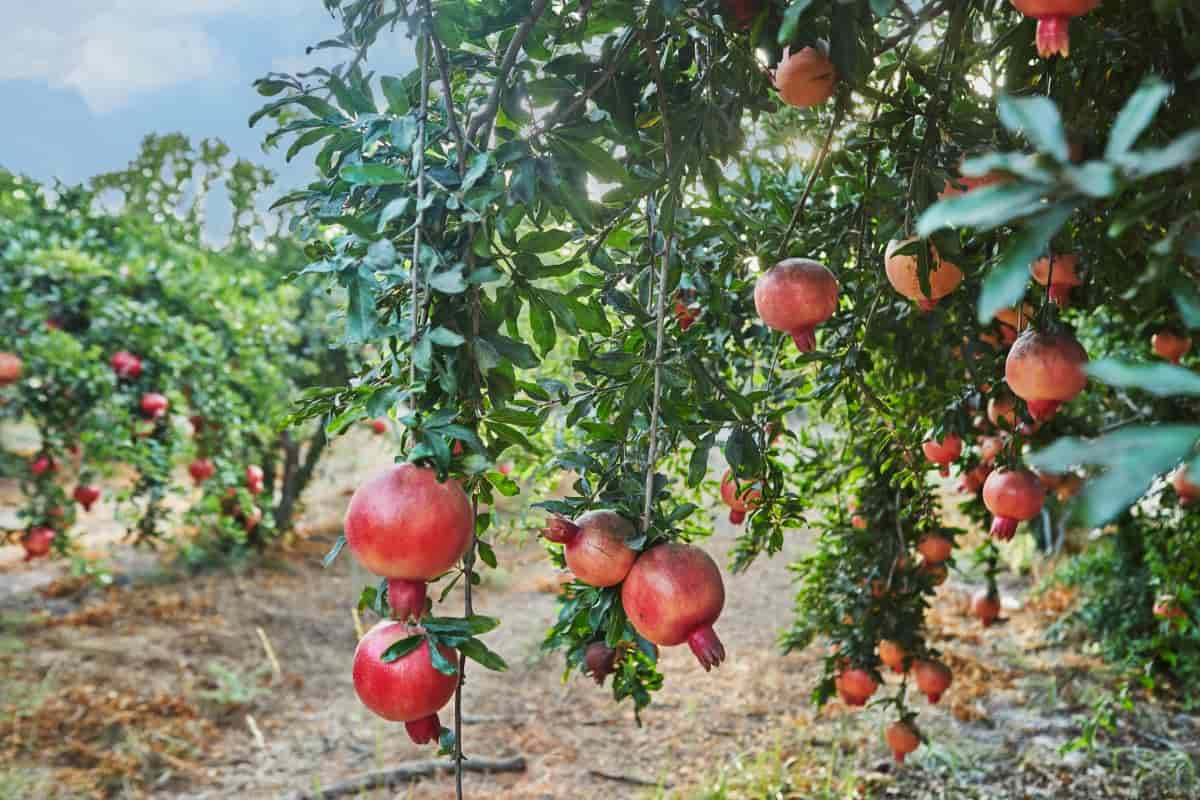
To ensure proper nutrient uptake, conduct soil tests periodically and fertilize accordingly using organic or balanced fertilizers. Adjusting nitrogen, phosphorus, and potassium levels based on the test results will help maintain healthy tree growth and fruit development. Implementing good soil management practices not only benefits your current harvest but also ensures sustainable production for years to come.
Climate and Environmental Conditions
Pomegranates thrive in regions with hot and dry summers, as they require plenty of sunlight to grow and ripen properly. These fruit-bearing shrubs can tolerate a wide range of temperatures but do best in areas with mild winters. Pomegranates are sensitive to frost, so it’s essential to protect them during colder months if you’re cultivating them in regions prone to freezing temperatures.
Additionally, strong winds can damage delicate flowers and young fruits, affecting the overall yield. Good air circulation is important for preventing Pomegranate diseases. Planting trees with enough space between them helps reduce humidity levels around the plants, decreasing the risk of fungal infections or other issues that thrive in damp environments.
Planting Techniques and Spacing
Before planting Pomegranates, ensure the soil is well-drained and fertile. Pomegranate trees thrive in full sun, so choose a sunny spot. Spacing between Pomegranate trees should be around 15-20 feet apart to allow ample room for root development and air circulation. Make a hole carefully twice as wide as the root ball. Place the tree carefully in the hole, backfill with soil, and water thoroughly. Regular watering during establishment is crucial to helping roots establish themselves.
Drip Irrigation and Water Management
Drip irrigation is a game-changer in Pomegranate farming. It delivers water to the roots, promoting optimal growth and fruit development. This method ensures that every drop counts, leading to efficient water usage and cost-effectiveness. Proper water management is crucial for healthy Pomegranate plants. Monitoring soil moisture levels and adjusting irrigation can prevent both under-watering and overwatering issues. Pomegranates thrive in well-drained soils, making drip irrigation an ideal choice for maintaining the right moisture balance.
In case you missed it: High Density Pomegranate Cultivation – In India
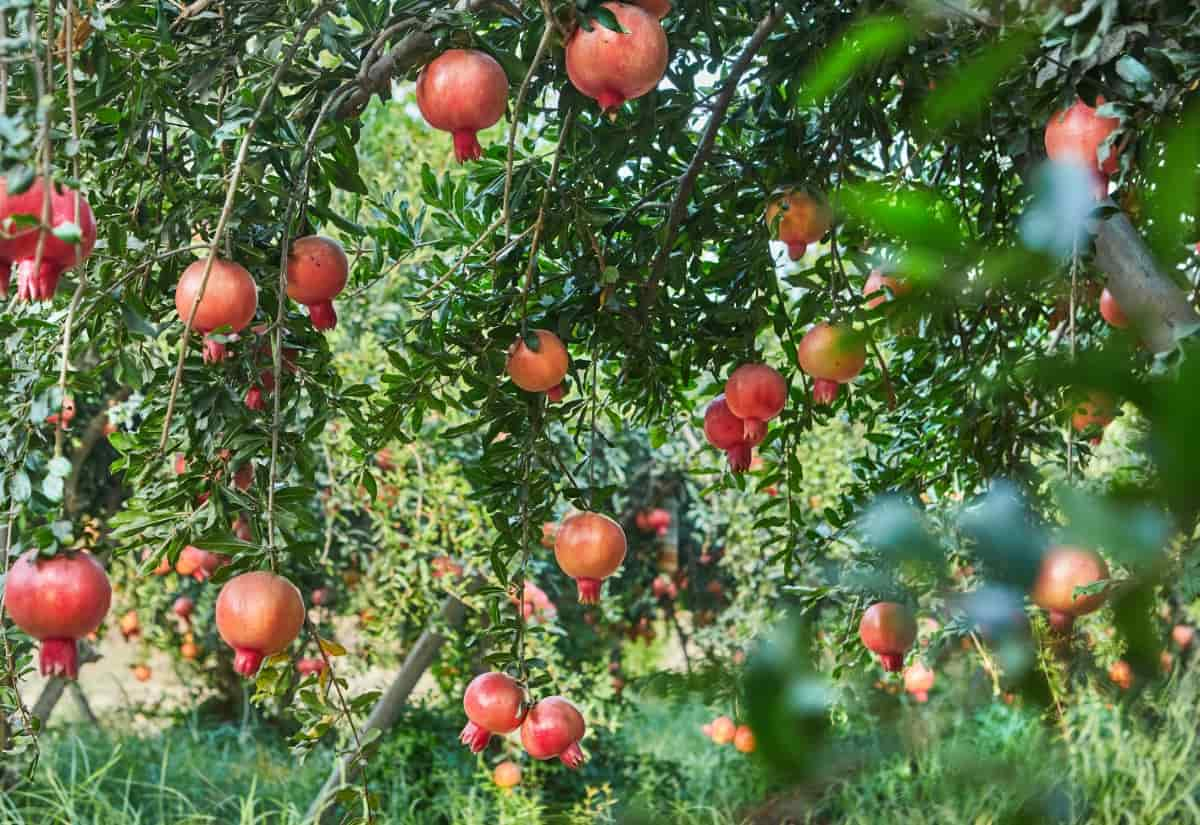
Drip irrigation encourages deep root penetration by providing a consistent supply of water at the root zone, enhancing plant stability and nutrient absorption. This precision watering technique reduces weed growth and minimizes water wastage through evaporation or runoff. With drip irrigation systems, farmers have greater control over how much water each tree receives. This approach not only conserves resources but also promotes higher yields of quality fruits. Efficient water management practices are key to sustainable Pomegranate cultivation.
Fertilization and Nutrient Management
Providing the right nutrient balance is essential for the healthy growth of Pomegranate trees and optimal fruit production. Fertilization should be based on soil analysis results to ensure that the specific needs of the Pomegranate plants are met. A well-balanced fertilizer application can help improve tree vigor, flowering, and fruit quality. Macronutrients like nitrogen, phosphorus, potassium and micronutrients like zinc and iron play a major role in Pomegranate cultivation.
It’s important to monitor nutrient levels throughout the growing season and adjust fertilization practices accordingly. Organic fertilizers can also enhance soil health and promote sustainable farming practices. Compost or manure applications can help increase the soil’s organic matter content, improving its structure and fertility over time.
Pruning and Canopy Management
Proper pruning helps maintain the plant’s shape, encourages fruit production, and improves overall plant health. Regularly removing dead or diseased branches promotes airflow within the canopy, reducing fungal diseases. Pruning also allows sunlight to reach the lower parts of the plant, aiding in uniform fruit development. Pruning Pomegranate plants during their dormant season is essential to avoid disrupting flowering and fruiting cycles. Removing excessive growth helps balance vegetative growth with fruit production.
Maintaining an open canopy structure through strategic pruning enhances pollination by allowing easier access for bees and other pollinators. Additionally, a well-managed canopy facilitates pest control measures by improving visibility and accessibility for monitoring. Proper pruning techniques contribute significantly to maximizing yield potential while promoting overall orchard health in Pomegranate cultivation practices.
Pest and Disease Control
Pomegranate trees are susceptible to various pests like aphids, whiteflies, and thrips that can damage the fruit and foliage. To combat these pests, integrated pest management practices should be implemented. Using natural predators like ladybugs or releasing beneficial insects can help control pest populations without harming the environment. Regular monitoring of the orchard for any infestation signs is essential for early detection and prevention of widespread damage.
Additionally, practicing good sanitation by removing fallen leaves and fruits can reduce diseases such as fungal infections. Applying organic fungicides, when necessary, can further protect the trees from common diseases like powdery mildew or bacterial blight. By implementing proactive measures and staying vigilant against potential threats, farmers can effectively manage pest and disease issues in their Pomegranate orchards for a successful harvest season.
Pollination and Fruit Set
Pollination and fruit set play crucial roles in ensuring a successful harvest. Pomegranate flowers are typically self-pollinating, but cross-pollination can lead to higher yields and better-quality fruits. Encouraging pollinators to visit your orchard can significantly improve the fruit set. To enhance natural pollination, avoid using pesticides that may harm these beneficial insects.
In case you missed it: Growing Dwarf Pomegranate – From Seed, Winter Care
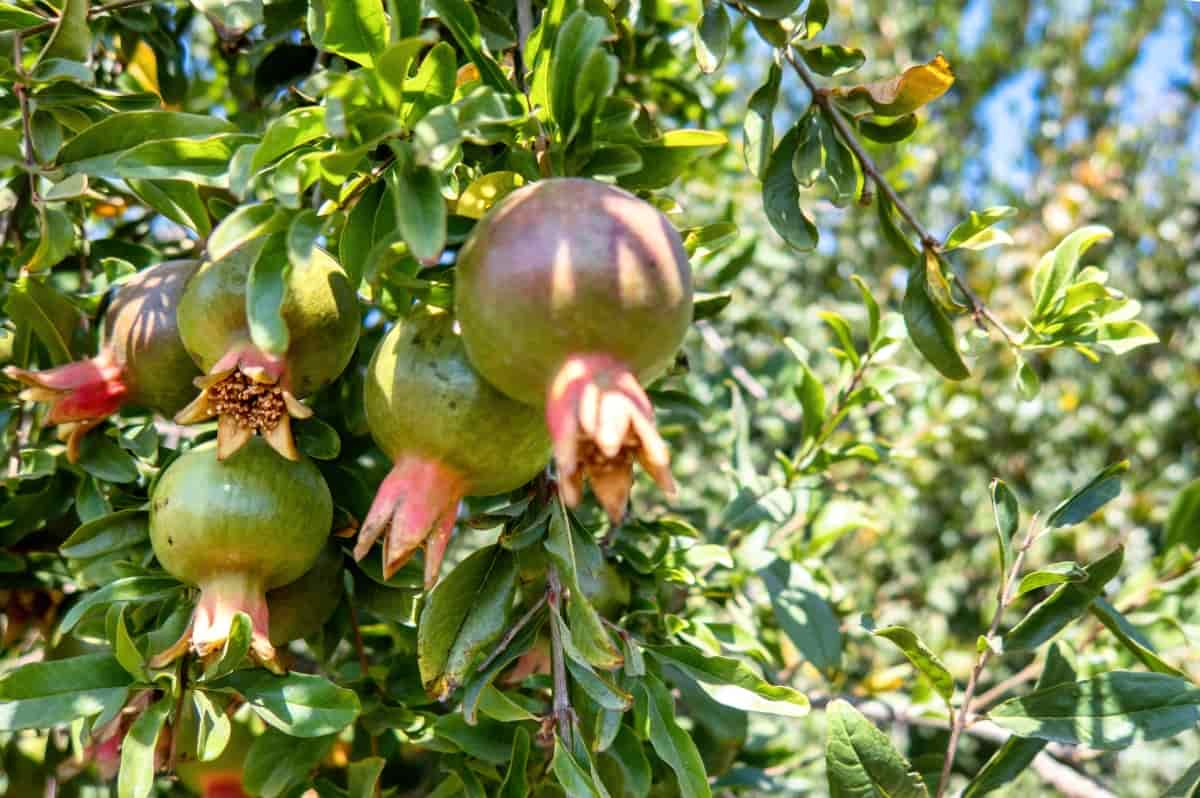
Timing is key to pollination. For an optimal fruit set, flowering should occur during periods when pollinators are active. Additionally, proper nutrition and irrigation throughout the growing season can support healthy flower development and increase the chances of successful fertilization. By understanding the importance of pollination and taking steps to promote effective fruit set, Pomegranate farmers can maximize their crop yield and quality.
Tips to Boost Flowers and Yield
Firstly, ensure proper pruning practices by removing dead or crowded branches to promote healthy growth and better fruit production. Another tip is to maintain optimal soil moisture levels through regular irrigation. Pomegranates thrive in well-drained soil with consistent watering, especially during dry periods. Additionally, applying organic mulch around the base of the plants helps to suppress weed growth.
Furthermore, adequate sunlight is crucial for flower bud formation and fruit development. For optimal results, make sure your Pomegranate trees receive 6-8 hours of direct sunlight daily. Consider investing in quality fertilizers rich in potassium to encourage flowering and increase overall yield.
Monitor your Pomegranate plants regularly for signs of pests or diseases and take correct measures to prevent infestations. Implement a consistent watering schedule, especially during the fruiting season, to promote healthy tree development. Prune your Pomegranate trees regularly to encourage better fruit production and improve overall tree health. Stay informed about best practices for fertilizing your orchard to provide essential nutrients at the right time.
Harvesting Techniques and Timing
Pomegranates are typically ready for harvest in late summer to fall, depending on the variety and geographical location. One way to determine if a Pomegranate is ripe is by its color; a deep red hue signals readiness. Harvesting too early can result in underripe Pomegranate fruits with a lack of sweetness and vibrant color. On the other hand, waiting too long may lead to overripe fruits that are prone to splitting.
Harvesting techniques involve gently twisting the fruit until it breaks off from the tree or using shears to cut the stem close to the calyx. Be careful not to bruise or damage the fruit during harvest, as this can affect its shelf life and market value. By knowing harvesting techniques and timing, farmers can ensure a bountiful yield of delicious and nutritious Pomegranates each season.
Expected Yield
The average Pomegranate yield per acre can change based on factors such as variety, climate, soil quality, and management practices. Commercial varieties like Wonderful, Hicaznar, and Mollar de Elche are known for their high yields. With proper care and attention to detail during cultivation, farmers can achieve a bountiful harvest of Pomegranates.
In case you missed it: Top 20 Steps to Boost Pomegranate Yield: How to Increase Pomegranate Fruit Size, Quality, and Production
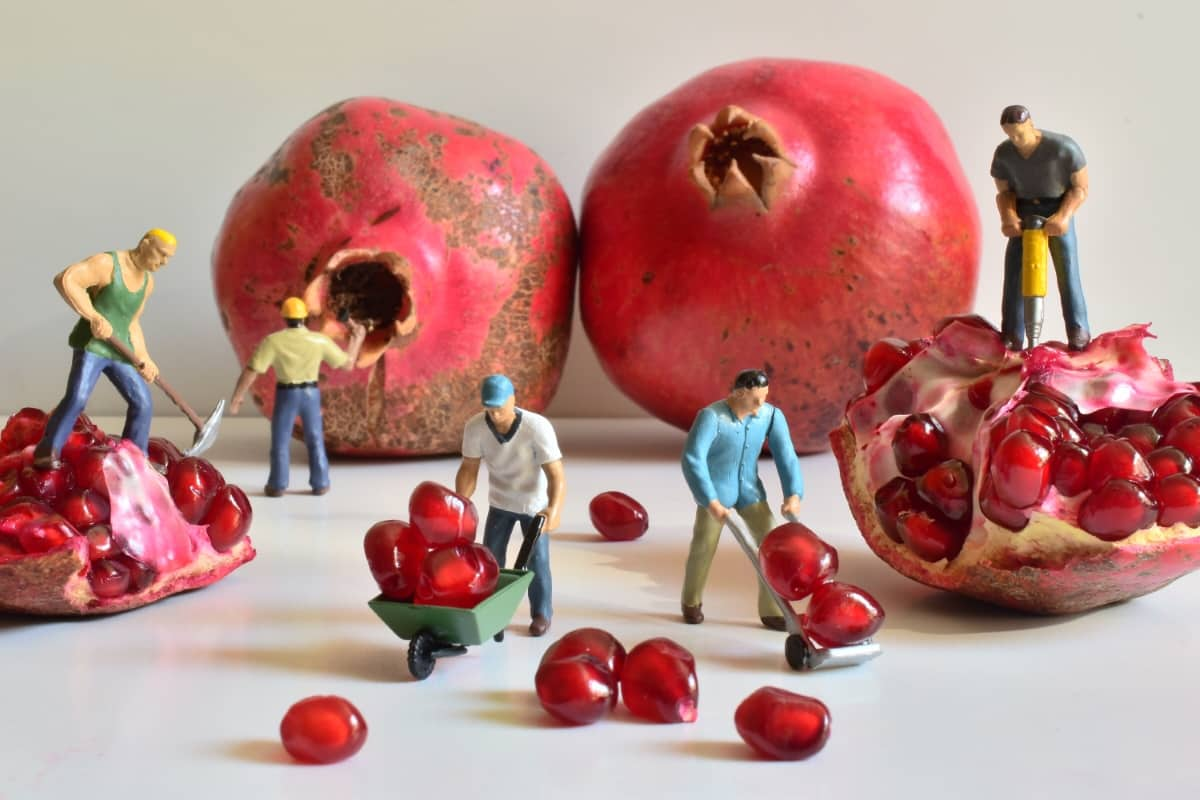
In ideal conditions, a well-established Pomegranate orchard can produce 15 to 25 tons per hectare. However, yields may fluctuate from season to season due to weather fluctuations or pest infestations.
Post-Harvest Handling and Storage
Post-harvest care is essential for prolonging shelf life and ensuring customer satisfaction. Once harvested, Pomegranates should be carefully sorted to remove any damaged or spoiled fruits. Proper handling techniques, such as avoiding rough treatment and storing at optimal temperatures, can prevent bruising and extend freshness.
Storage conditions play a major role in maintaining the fruit’s taste and appearance. Pomegranates are best stored in cool, dry environments with good air circulation to prevent moisture that can lead to decay. Packaging also matters in post-harvest handling. Using suitable containers that protect the fruits from physical damage during transportation is key to preserving their quality until they reach consumers’ hands.
Marketing and Sales Strategies
Utilizing social media can help reach a larger audience. Sharing engaging content such as recipes, fun facts, or behind-the-scenes farm stories can create buzz around your Pomegranate products. Collaborating with local markets, restaurants, or juice bars can also be beneficial in promoting your Pomegranates. Offering tastings or special promotions can entice customers to try your products.
In case you missed it: Bahar Treatment in Pomegranate for High Quality and Yields: A Step-by-Step Guide to Implementation
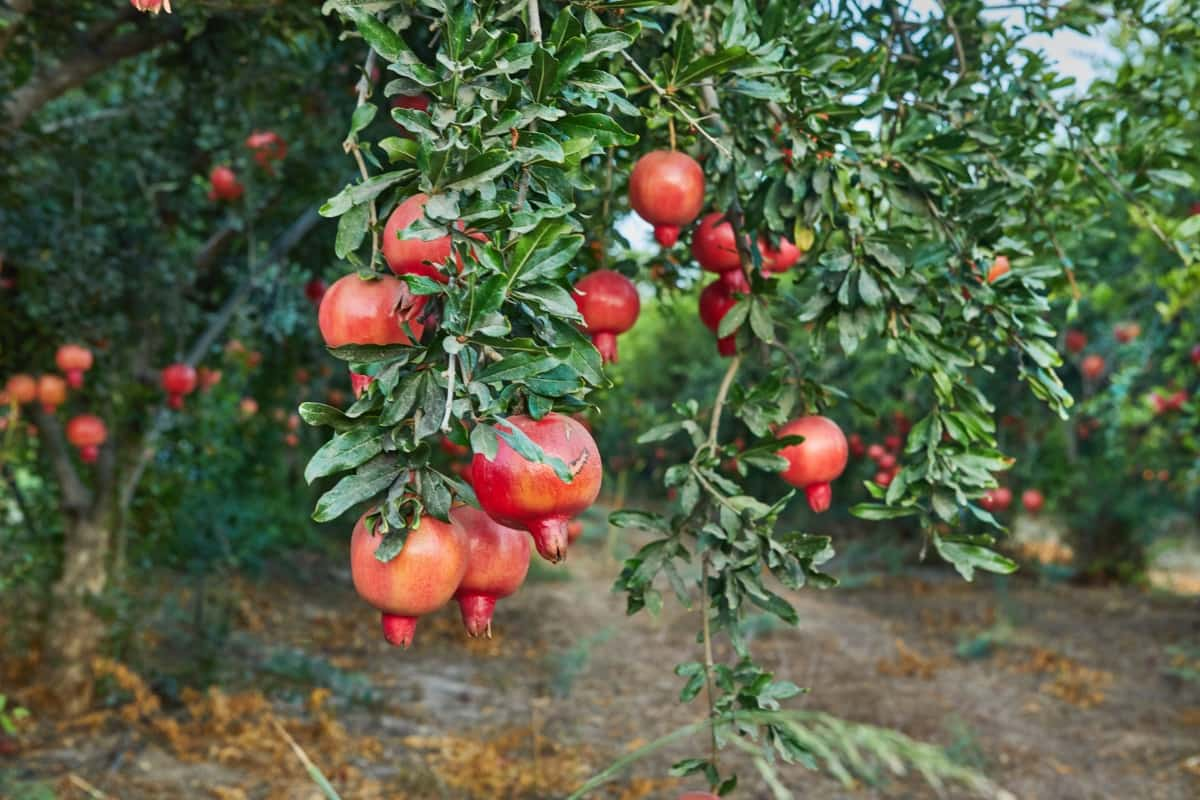
Packaging plays a crucial role in attracting buyers. Eye-catching labels and eco-friendly packaging can set your Pomegranates apart from competitors on the shelf. Building relationships with distributors and wholesalers is key to expanding your market reach. Attend trade shows or farmers’ markets to network and establish connections within the industry.
Sustainability Practices in Pomegranate Farming
Implementing sustainable methods helps conserve resources and reduce environmental impact. One key aspect of sustainability is using organic fertilizers and natural pest control ways to minimize chemical usage and promote soil health. Incorporating cover crops can also help improve soil structure, prevent erosion, and enhance biodiversity on the farm.
Water management techniques such as drip irrigation not only save water but also optimize its use by delivering it directly to the roots where it’s needed most. This practice reduces water wastage and promotes efficient growth without over-saturating the soil. Furthermore, practicing crop rotation can help prevent soil depletion, control pests naturally, and maintain a balanced ecosystem within the farm.
From understanding the ideal climate and soil conditions to selecting the right variety for your farm, every planting step plays a crucial role in the success of your harvest. Proper harvesting, storing, and selling practices are essential to preserving the quality of your fruit and maximizing profits.
- Economical Aquaculture: A Guide to Low-Budget Fish Farming
- 15 Common Planting Errors That Can Doom Your Fruit Trees
- How to Make Houseplants Bushy: Effective Tips and Ideas
- Innovative Strategies for Boosting Coconut Pollination and Yield
- Pollination Strategies for Maximum Pumpkin Yield
- The Complete Guide to Chicken Fattening: Strategies for Maximum Growth
- Natural Solutions for Tulip Problems: 100% Effective Remedies for Leaf and Bulb-Related Issues
- Revolutionizing Citrus Preservation: Towards a Healthier, Greener Future
- Natural Solutions for Peony Leaf and Flower Problems: 100% Effective Remedies
- Maximizing Profits with Avocado Contract Farming in India: A Comprehensive Guide
- Natural Solutions for Hydrangea Problems: 100% Effective Remedies for Leaf and Flowers
- The Ultimate Guide to Choosing the Perfect Foliage Friend: Bringing Life Indoors
- From Sunlight to Sustainability: 15 Ways to Use Solar Technology in Agriculture
- The Ultimate Guide to Dong Tao Chicken: Exploring from History to Raising
- The Eco-Friendly Makeover: How to Convert Your Unused Swimming Pool into a Fish Pond
- Mastering the Art of Delaware Chicken Farming: Essentials for Healthy Backyard Flocks
- 20 Best Homemade Fertilizers for Money Plant: DIY Recipes and Application Methods
- How to Craft a Comprehensive Free-Range Chicken Farming Business Plan
- Brighten Your Flock: Raising Easter Egger Chickens for Beauty and Bounty
- How to Optimize Your Poultry Egg Farm Business Plan with These Strategies
- Subsidy for Spirulina Cultivation: How Indian Government Schemes Encouraging Spirulina Farmers
- Ultimate Guide to Raising Dominique Chickens: Breeding, Feeding, Egg-Production, and Care
- Mastering the Art of Raising Jersey Giant Chickens: Care, Feeding, and More
- Ultimate Guide to Raising Legbar Chickens: Breeding, Farming Practices, Diet, Egg-Production
- How to Raise Welsummer Chickens: A Comprehensive Guide for Beginners
- How to Protect Indoor Plants in Winter: A Comprehensive Guide
- Ultimate Guide to Grow Bag Gardening: Tips, Tricks, and Planting Ideas for Urban Gardeners
- Guide to Lotus Cultivation: How to Propagate, Plant, Grow, Care, Cost, and Profit
- Agriculture Drone Subsidy Scheme: Government Kisan Subsidy, License, and How to Apply Online
- Ultimate Guide to Raising Araucana Chickens: Breed Profile, Farming Economics, Diet, and Care
- Bringing Hydroponics to Classroom: Importance, Benefits of Learning for School Students
- Ultimate Guide to Raising Polish Chickens: Breed Profile, Farming Economics, Diet, and Care
- Ultimate Guide to Raising Australorp Chickens: Profile, Farming Economics, Egg Production, Diet, and Care
- Silkie Chicken Farming: Raising Practices, Varieties, Egg Production, Diet, and Care
- Sussex Chicken Farming: Raising Practices, Varieties, Egg Production, Diet and Care
- Homemade Feed Formulations for Livestock: Discover Cost-effective Starter to Finisher Feed Recipes
Latest pests and disease management information is required. Please post it.
We will update you soon.
Dear Sir,
I would like to ask a question,-
How cum pomegranates are available throughout the year in India compared to only a few months in a year as before?
I remember when I was a boy of 11 years during 1961 pomegranates were seen in the market during July, August, September.
But the rest of the year, not so much we could see in the market.
I am talking about city in Mumbai, Maharashtra and Surat Gujarat.
Is the agricultural Technique changed in recent years to make it available almost thru out the year?
Please advise.
Thanking you!.
Good Question. Can anybody is there to answer before we answer?
Where to buy kadaknath chicks ?
One of the most effective fertiliser management techniques for Pomegranate and similar crops is to aid the inputs along with cattle slurry/Jeevamrut. This slurry is a great source of friendly bacteria which enables/speeds up the mineralisation process by the virtue of which various macro, micro and Nano elements required for the crops are released. Jeevamrut application will not only help utilise already present elements in the soil but also create a self supporting ecosystem. It by default makes The soil more fertile and the fertiliser residues left over years of farming start getting utilised. It results into more porous soil, high fertility and hence better and higher yield. Due to increased porosity the water retaining capacity of the soil improves too. Jeevamrut is simple to prepare. It requires ingredients locally available. Cattle Dung and Urine, gram flour and jaggery are basic ingredients. These can be evenly mixed with water, stirred regularly and fermented for 4-5 days. This preparation needs to reach each plant’s root zone. The application process can get cumbersome and laborious if done manually. So one can also try to filter Jeevamrut and then send the filtered liquid through drip irrigation. While filtration of cow dung based liquid isn’t easy, product like “Pruthviraj Slurry Filter” can help. Once sided with this product the application process can become completely automatic. It will enable higher quantities given at higher intervals. You can visit jeevamrut.com to know more
Yes pomegranate are available throughout the year cose they can be stored in bookstores for up to six months with good higeine practices.
Any thoughts on “Bhagawa” variety? Apparently the yield is twice that of “Ganesh” variety. Can anyone share experience with this variety?